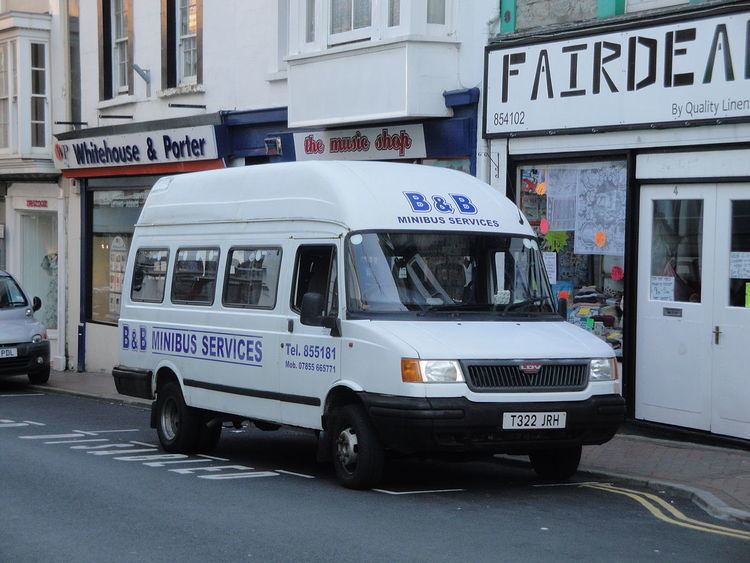Production 1984–2006 Related Successor LDV Maxus | Class Van Predecessor Freight Rover Sherpa | |
 | ||
Manufacturer British Leyland, LDV Limited | ||
The LDV Convoy is a panel van that was manufactured by LDV Limited between 1996 and 2006.
Contents
- Ancestors
- Freight Rover 300 Series 19841989
- Leyland DAF 400 Series 19891993
- LDV 400 and Convoy 19932006
- References
The Convoy was a development of the Leyland DAF 400 Series, which in turn was based on the Freight Rover 300 Series. The Convoy and its predecessors were the larger versions of the LDV Pilot (and its predecessors), all of which were based on the Leyland Sherpa series of vans that was first developed in 1974, sharing some components with even earlier models.
Ancestors
For information on the vehicle history prior to the 1984 Freight Rover 300 Series, see Freight Rover Sherpa.Freight Rover 300 Series (1984–1989)
In 1984 the Sherpa became known as the Freight Rover 200 Series, and gained square black headlamp bezels with round lamps (later replaced by the same rectangular headlamps as on the 300 Series), new black plastic bumpers (replacing the previous chrome with embellishers item), rounder wheel arches, redesigned rear door hinges, door handles, door shape and repositioned indicators (raised from the rear bumper to the hips on all panelled models thereafter). Alongside the original bodystyle there was a new wide-bodied variant – the 300 series, available in a choice of three wheelbase lengths. Of the 300 Series the 285 and 310 models were single wheel, the 300 and 350 models being twin. While capacity for the 200 series remained at 5.4 m³ (190 cu. ft), that of the 300 series ranged from 7.6 m³ (268 cu. ft) to 11.4 m³ (402 cu. ft), depending on the combination of wheelbase and roof profile (a high-roof was an option for the lwb 310 and 350 models).
For those who needed yet more space, a Luton-style body was offered, built on either the 255 or 350 chassis-cabs, providing capacities of 11.3 m³ (400 cu. ft) (with 200 series cab) or 15.6 m³ (550 cu. ft) (300 series), and a maximum payload of almost 2 tonnes. The chassis-cab also formed the basis for a standard- and wide-bodied drop-side pick-up, in 255, 280, 285, 310 and 350 versions, again available with either short- or long-wheelbases. Of course, the chassis-cab could also be ordered on its own, again in a choice of widths and lengths, so that bespoke bodywork could be fitted, with the added option of either single or double cabs. The 200 series continued to be offered as minibus or crewbus, but the 300 series was also offered as a minicoach seating up to 18 people.
While the K2 Sherpa's engine remained available (including the ancient B-series diesel), a 2.5-litre diesel unit was now offered on the 300 series, and following the completion of a special Police contract, the Rover 3.5-litre V8 unit also became available from 1986. However, with the merger of Freight Rover, along with the rest of the Leyland Trucks division of the Rover Group with DAF Trucks the following year, to form the new DAF NV and Leyland DAF companies, the Rover Group ceased to be a player in this sector of the light commercial market.
Leyland DAF 400 Series (1989–1993)
With Freight Rover becoming part of Leyland DAF the 300 series was superseded by the 400 series, which also offered air suspension and a 2.5-litre Peugeot-sourced diesel engine(Changed later on for the Ford Di engine from the Transit). At this stage, it was given a new radiator grille, bearing the Leyland DAF badge.
LDV 400 and Convoy (1993–2006)
Following the sell-off of the van business from the insolvent Leyland DAF in 1993, LDV Limited was formed. In 1996 the 400 van received a facelift and was renamed the Convoy.
The Convoy was available in 2.8 tonne, 3.1 tonne and 3.5 tonne variants with load volume capacities up to 12.9 cubic metres. The van would become hugely popular as a minibus and would come in pick-up and fleet based vans.
By the mid-2000s however, it was clear that the platform (which harked back to 1974) had run its course and was now terminally dated in comparison to the competition (by way of comparison, its main rival - the Ford Transit, had had two complete redesigns launched within the lifetime of the entire Sherpa/Freight Rover/Pilot/Convoy series), the van's key selling point for operators such as the Royal Mail (who had operated large fleets since the original Sherpa version), and local authorities had been its narrower track compared to the Transit, enabling it to negotiate tight alleyways and country lanes. The last Convoy was built in 2006, succeeded by the Maxus.
